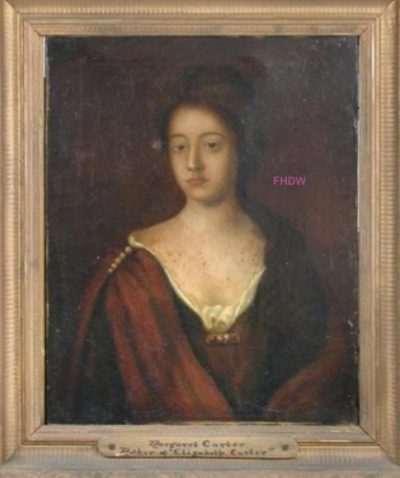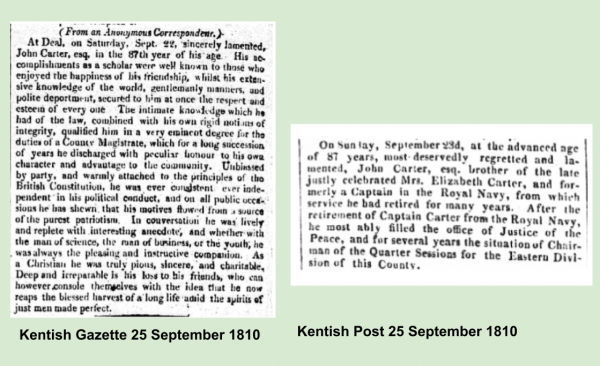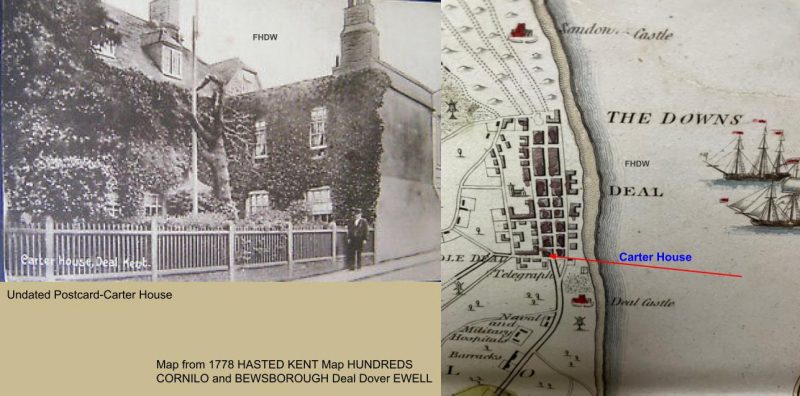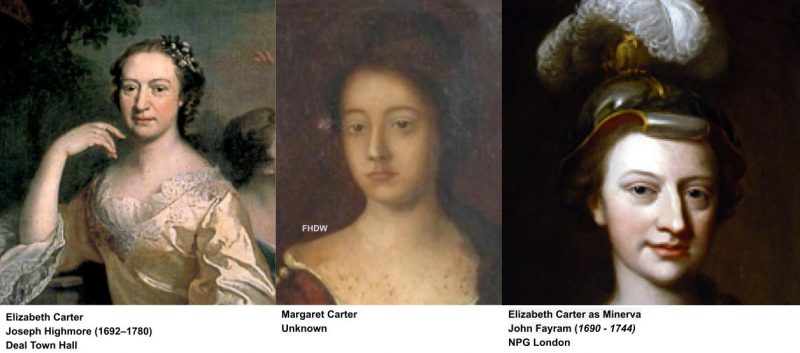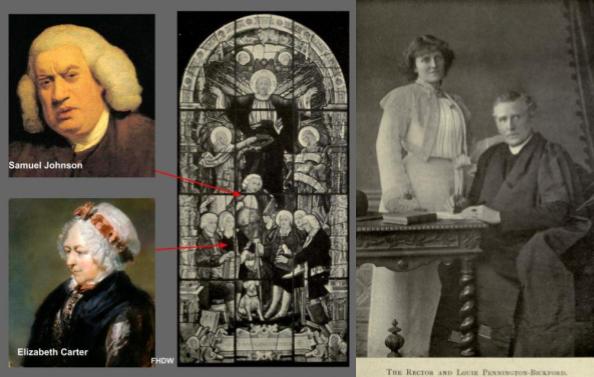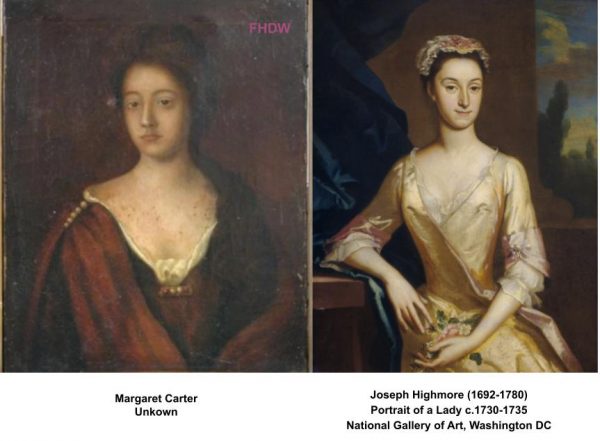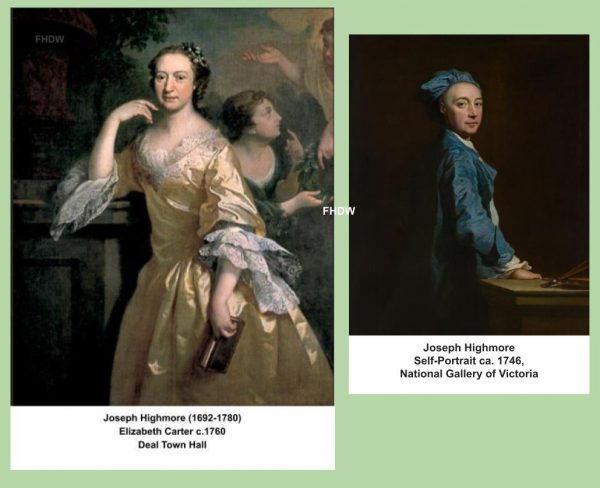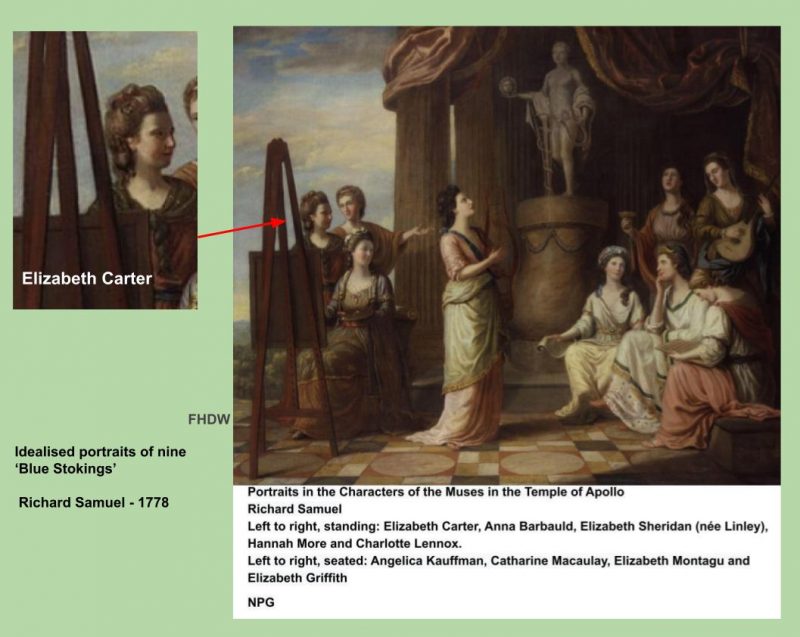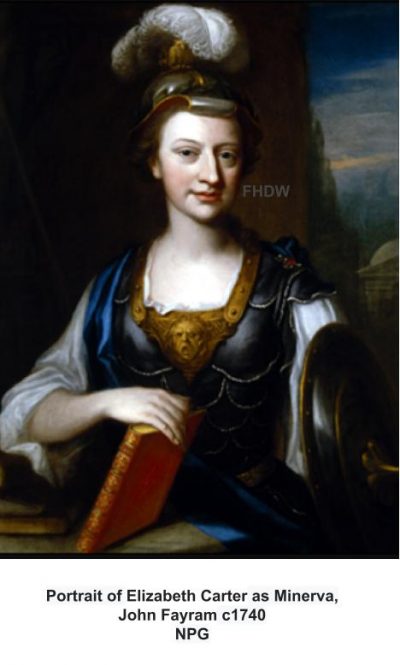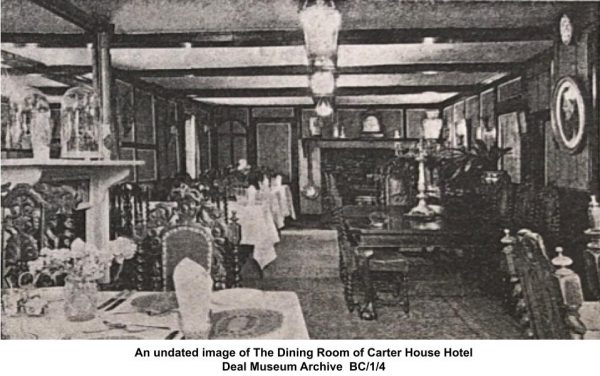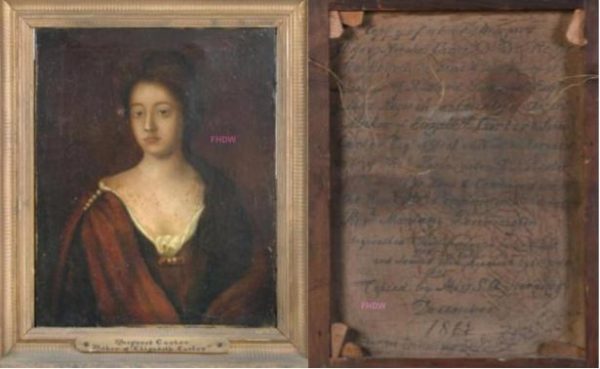Follow us on Facebook @FHofDW
A Portrait
With a friend, we were lucky enough to visit a house in Deal whose owners were putting its many, varied and beautiful contents up for auction. One painting in particular caught our eyes. It was that of Margaret Carter, wife of Rev. Nicholas Carter and mother of Deal’s very own Blue Stocking, Elizabeth Carter.
On the reverse of the canvas someone has written
“Copy of a portrait of Margaret, wife of Nicolas Carter D:D. Rector of Woodchurch, Kent & sole daughter and heir of Richard Swayne Esq of Bere Regis in the county of Dorset. Mother of Elizabeth Carter and John Carter Esq of Deal in Kent and Margaret wife of Thomas Pennington D:D. Rector of (Thorley) Herts and grandmother of the Rev. Thos Pennington & the Rev Montagu Pennington. Bequeathed to Thomas Pennington by his aunt Mrs Elizabeth Carter and cleaned and repaired by his order 1836. Copied by Miss S A Harding December 1861”.
This then gave us some interesting details on which to start our research.
***
Born in 1690 Margaret was the daughter, and heiress, of Richard Swayne and the unnamed daughter of Thomas Trenchard of Wolverton, and Lychet Maltravers in Dorset.
Where Margaret met her future husband, we don’t know; Nicholas at that time was the Vicar of Tilmanstone, a village five miles from Deal. Following their marriage, on August 6, 1716, in Bere Regis, Dorset, the couple would have travelled back to Kent and set up home in the parish vicarage. The vicarage, though, being old and not to his liking Nicholas, in 1719, obtained a licence from the Archbishop of Canterbury to take it down and rebuild it. Over one hundred years later another incumbent also did the same.
By the early 18th century Deal had become a thriving bustling place with much of its trade happening in the lower part of the town, situated alongside the sea shore. The parish church of St. Leonard’s being a mile away, in Upper Deal, was becoming too small for the expanding community and for some they were finding it inconvenient to get to. A new church was therefore needed; so St. George the Martyr was built as the Chapel of Ease for St. Leonard’s.
The chapel was consecrated in the month before Margaret and Nicholas married and Rev. William Squire, M.A. was appointed as its first Perpetual Curate. Two years later on March 16, 1718, Nicholas took over the Curacy, a position he would hold for fifty-six years.
Margaret probably spent most of her time in Deal and certainly was there in 1717 as it was here that on 16th December that her first and best known child, Elizabeth was born. It was in the chapel that Nicholas was soon to become Curate, that she was baptised on January 1, 1717/8.
-
-
-
-
-
-
-
- Elizabeth Carter 1717-1806
- Nicolas Carter 1718–1740
- James Carter 1720–1735
- John Carter 1723– 1810
- Margaret Carter 1725–1798
-
-
-
-
-
-
As well as Elizabeth our Blue Stocking there were two sons who died early: Nicholas and James; Margaret, her youngest daughter, married a successful and respected minister Rev. Thomas Pennington whose youngest son, when Rev. Montagu Pennington, would edit and publish his famous aunts letters; through his elder brother Rev.Thomas Pennington the many personal items, documents, manuscripts, family paintings and indeed the house we know as Carter House would continue to be passed through the family. John married three times and became a Naval Officer then a Magistrate but, perhaps unusually for the time, he was always in the shadow of his elder sister with his obituary in the Kentish Weekly newspaper saying he was the brother of the “…justly celebrated Mrs. Elizabeth Carter…”
Margaret would sadly not live to see her children grow. Although we don’t know for certain where she died she was buried in St. Andrew’s Church, Tilmanstone, on October, 16, 1728.
It was suggested by Rev. Montagu Pennington, Margaret’s Grandson, that the cause of her death was of the great despair she fell into after losing a fortune when the South Sea bubble burst in 1720. As she dies eight years after the bubble burst it seems more likely that she succumbed to a more physical rather than mental affliction.
Margaret had brought to the marriage several thousand pounds which the couple decided to invest in The South Sea Company When the bubble burst they, it seems, did not lose everything but enough for Nicholas to be “…so much affected by it that he never willingly mentioned it nor chose to say how large a sum he had thus lost…” In his Will he mentions a fund called The South Sea Annuities , with £150 capital stock (approx. £13,000 today), which he bequeathed to his and Margaret’s surviving children, John, Margaret and Elizabeth. These Annuities continued to be passed to their descendants until the company was finally wound up in 1855.
Elizabeth was to become a supporter for the abolition of slavery and a member of the Abolition Society at its formation in 1787. The society was dependent upon subscribers and appears in the the printed ‘List of the Society, instituted in 178, for the purpose of effecting the abolition of the slave trade’ subscribing £3. 3s. (today approx. £240)
There are no records to tell us how Margaret or Nicholas felt about slavery or if it was discussed in the family home either before the investment or afterwards.
***
Nicholas, like many widowers of the time, was soon to remarry. After all, not only Curate of Deal’s St. George’s (1718-1774) he was Curate of Sutton by Dover (1716-1755), Vicar of Tilmanstone (1716-1755), Rector of Woodchurch (1755-1774,) Rector of Ham (1734-1755) and was one of the six preachers at Canterbury Cathedral (1726-1774), he would then have desperately needed someone to help care for his house and his children. So on April 8, 1729 in St. Leonard’s, Deal, Nicholas married Mary Bean by licence and they too had four children.
-
-
-
-
-
-
-
-
-
-
-
- Mary 1730- c1778
- Sarah 1736-1736
- Henry 1739-1813
- Ann 1741-1741
-
-
-
-
-
-
-
-
-
-
Mary’s eldest daughter and namesake, known as Polly, married Doctor Andrew Douglas: Henry was educated by his eldest sister Elizabeth. He too took holy orders and was for fifty years the rector of Little Wittenham in Berkshire.
Mary died in 1759 and was buried in St. George’s Church, Ham, alongside her baby daughter’s Sarah and Ann. Was a portrait ever made of Mary? We have found no trace. The cost of a professional artist may have simply been too prohibitive; a half length portrait at the time, depending on the artist, would cost anything from 20 guineas. Today that would be over £2,000.
***
With the death of her step mother the “task of keeping her father’s house” fell to Elizabeth. She had, encouraged by her father, spent the winter months in London, from around 1735, where she made and socialised with her literary ‘Blue Stocking’ friends. With the publication of her translation of Epictetus in 1758, the first ever English translation, bringing her £1,000, she decided to invest in a property in Deal where both she and her father could live. She purchased the lease, from the Archbishop of Canterbury, of several adjoining tenements on South Street. While work was carried out to repair and alter the property to give both her father and herself separate apartments, she decided to travel on the continent. At this time the house on South Street was on the “extremity” of the town and covered with ivy. From her room she wrote to her friend, Catherine Talbot, “..I have on one side a fine view of the country and on the other the sea…”
Nicholas died here, in this house, in 1774 leaving no mention of any paintings or portraits in his will. He may have already given to his surviving children those that he owned, including the original portrait of Margaret. He was buried alongside his second wife Mary in St. George’s Church, Ham.
Elizabeth herself died in her London Clarges Street home in 1806 and was buried in the grounds of Grosvenor Chapel, London. A memorial was later erected to her memory, by her nephew Rev. Montagu Pennington, in Deal’s St. George’s Chapel.
***
But where did the original portrait of Margaret Carter hang? We assume it was, at first, in the Deal residence of Nicholas Carter. So where was this? Well, no one really knows for certain. In his ‘Memoirs of the life of Mrs. Elizabeth Carter’ Rev. Montagu Pennington, when writing about Elizabeth’s decision to buy ‘Carter House’, wrote that Nicholas
“…lived in a hired house at Deal, subject from different causes, to the inconvenience of frequent removals. She thought it best to buy a house for herself in which her father might live with her…”
Which suggests that, over his many years as curate, there were quite possibly several residences.
Laker records the replies to the Visitation questions, made by the newly appointed Archbishop Thomas Secker in 1758, in which Nicholas Carter says
“…There is no house belonging to the Curacy of the Chapel and I have constantly resided in the Lower Town ….”
Laker also says that Nicholas Carter “..resided in a house in Lower Street which was demolished when Park Street was constructed…” So far we have found no evidence for this, but his son John did own a house, on Lower Street, (now High Street) known as Park House, which he left to his third wife Anne in 1810. Hasted, in 1800, described this house as “…now belonging to John Carter esq, on the west side of Lower Street …” which he suggests dated back to 1623.
With certainty we know that Park House was sold, in 1847, by John Carter’s daughter Hannah and her husband George to make way for a new road. John’s wife Ann died in Malta in 1844.
Could this have also been a residence of Nicholas and Margaret and if so did her portrait hang there?
The details of where Nicholas lived, and where Margaret’s portrait was hung, before 1762, will possibly remain a mystery.. We do know with certainty Margaret’s portrait was in Elizabeth’s possession and probably hanging in Carter House when she made her will, in which she bequeathed the portrait to her nephew Rev. Thomas Pennington, son of her sister Margaret. Thomas and his brother Rev. Montagu Pennington jointly inherited Carter House from their aunt. Montegu was married, in 1804, to widow Mary Watts; died childless in 1849 leaving his share of Carter House to Thomas.
Excerpt from the will of ELizabeth Carter, highlighting Margaret’s portrait ~ “my mothers portrait”
Thomas was the Rector of St. James the Great in Thorley and having died in Carter House in 1852, he bequeathed the portrait and Carter House to his daughter Theodora Louisa.
Theodora married, former army Captain, Robert George Sparrow in Westminster on August, 20, 1816 and rather interestingly the couple also married a month earlier at Gretna Green on July 27. Their eldest son was baptised in Thorley after which they toured Europe which is where most of their children were born, some of whom they gave wonderful names.
-
-
-
-
-
-
-
-
- Thomas Sale 1817–1859
- Montagu Pennington Florentio Romulus 1819–1884
- Robert Pennington Remus 1820–1866
- George Waterloo Pennington 1821–1863
- Charles Henry Carter 1822–1822
- Mary Sarah 1823–1861
- William Cunningham Fairlie 1826–1882
- Theodora Louisa 1827–1869
- Eliza Jemima Lucas 1829–1910
- Sigismunda Elizabeth Cecilia 1833–1919
- Christiana Georgiana Julia Emma 1835–1873
- John James Horatio Septimus 1837–1910
- Thomas Sale 1817–1859
-
-
-
-
-
-
-
Excerpt from the will of Rev. Thomas Pennington highlighting Margaret’s portrait ~ “my Grandmothers portrait”
Theodora died in Carter House in 1869, so she would have been present or at least known about the copy of Margaret Carter’s portrait being made by her future daughter-in-law Sarah Ann Harding, in 1861.
Excerpt from the will of Theodora, highlighting Margaret’s portrait ~ “my Great Grandmothers Carter”
Up until this point the original portrait of Margaret Carter has been clearly mentioned in the family wills as a bequest passing through the Carter, Pennington and Sparrow families. Sadly it is not mentioned in the will of the last known owner Montagu Sparrow, Theodora’s second son, so after this we lose sight of the original painting. She also bequeathed to him a small picture of his Great, Great, Grandfather, as well as other pictures and portraits including one of Wolverton House, the seat of the Trenchards, which still stands today.
***
When Sarah Ann painted her copy of the Margaret Carter portrait, she was living with her parent’s, Job and Susannah, and her two younger sisters, in 3 Castle Terrace, Prospect Place, (now 61 Victoria Road, Deal) Job was a surgeon, though, he seems to have stopped practising from as early as 1851 as that year’s census states, as it does in 1861, that he was a ‘Surgeon not practising.’ Job died in his Ramsgate home in February 1863, with Sarah Ann by his side.
He was only fifty years old so was perhaps ill, maybe even treating himself, as his death certificate states he died of “Exhaustion from reaction after stimulants.” His wife, Susannah had died the previous year so with their fathers death, Sarah Ann then aged then aged twenty-five and her sisters, Susannah aged twenty-three and Laura aged seventeen, were left to care for themselves. Although Job had left them fairly, financially secure with just under £2,000 as well as the home in Ramsgate.
All three girls were soon to marry. Sarah Ann married in 1863 to Theodora’s youngest son John James (Septimus Horatio) Sparrow who by 1866 had been appointed the vicar of St. Peter’s Church, Westcliffe. It seems probable that the sisters were living with Sarah Ann and John James at the time of their marriages as both Susannah and Laura were married by their brother-in-law in St. Peter’s Church.
Sarah Ann and John James followed his parents in giving their children extraordinary names, to which Pennington was added when In 1886 John James assumed the surname of Pennington. Perhaps for sentimental reasons; as he was the last surviving male of the Pennington family.
It’s also interesting to note that they named not only their house, Trenchard House, in Willesborough, near Ashford, but also their fifth child, Charles George Trenchard Sale Sparrow, after their ancestor Thomas Trenchard.
-
-
-
-
-
-
-
-
- Georgina Louisa Susanah Horatia Sarah Harding 1864-1941
- Adam Edward Haslewood Pennington 1867-1887
- Archibald Langdon 1869-1932
- Septimus Adolphus Benjamin Carter Cullen 1872-1935
- Charles George Trenchard Sale 1874-1952
- Ethel Mary Gertrude Catherine 1875-1877
- Cuthbert Bertram Thomas Pennington 1877-1960
- Emma Kate Knighton Seymour Elizabeth Carter 1879-1963
- Nona Augusta Lizzie Welldon Julia Pennington 1880-1962
- Mary Mabel Howe Ada Decima Muncaster 1881-1958
-
-
-
-
-
-
-
As a point of interest Sarah Ann, in September 1862 purchased cottages at Cliffe Place, St. Margaret’s, at an auction held at the nearby Walmer Castle Inn, Deal. This property remained in the family until its sale in 1919.
Now obviously we don’t know how accurate Sarah Ann’s copy of her Margaret Carter portrait is to the original, but there seems a definite family likeness between the two known portraits of the young Elizabeth Carter and that of her mother by Sarah Ann.
Why she chose that particular painting to copy we don’t know but, we can hazard a guess. She would, we believe, have known of Elizabeth Carter and of her house in South Street. It would also be reasonable to expect the Sparrow family, living in Carter House, to move in the same circles as the Hardings. Sarah Ann then, may have met and socialised with the Sparrow family in Deal and was invited to the house where she would have seen the portrait of Margaret Carter and the other family paintings.
We also know that in 1861 her future husband, John James, was visiting his mother, Theodora. So it is tantalising to imagine they had met, at one of the Balls held at the Assembly Rooms then on the corner of Union Road, or through a mutual friend or even while attending St. George’s Church, which by then, in 1852, had become a Parish Church.
John James and Sarah Ann remained in the parish of Whitfield and Westcliffe until 1871 when he was appointed the living of St. Mary’s the Virgin at Willesborough. The couple must have been very happy there as both requested to be buried in the church yard. John James in 1910 and Sarah Ann in 1912.
From 1889 until 1910 John James was the Rector of St. Clements Dane Church, The Strand, London.
In the nave was a window dedicated to Samuel Johnson. It was paid for by a subscription fund set up by John James in 1909. Samuel Johnson was depicted surrounded by his literary friends including Elizabeth Carter, great aunt to John James. Sadly the Church took a direct hit from an incendiary bomb in 1941 leaving only the outer walls and the tower standing.
While no image of Sarah Ann has so far been found there is one of John James and their daughter Louie, taken while he was Rector of St. Clements and featured in the book he published ‘Interesting Reminiscences of St. Clement Danes Church, Strand.’ Again we think there is a strong family likeness.
***
As already indicated when, where or by whom the original portrait of Margaret Carter, was made or even if it is still in existence we simply don’t know. Was it painted prior to her marriage? Could it have been a companion to a portrait of her husband, Nicholas, as mentioned by Rev. Montagu Pennington in ‘Memoirs of the life of Mrs. Elizabeth Carter’, published in 1807?
“There is a portrait of him by Highmore, esteemed a very good likeness, in the possession of his eldest son, Mr. Carter of Deal. There was a very striking resemblance between him and his three eldest surviving children”
‘Mr Carter’ being John Carter esq. of Park House. Sadly this portrait is not mentioned in his will so we are also left not knowing if this portrait still exists either. As said earlier Theodora, his niece, bequeathed to her son, Montagu Sparrow, a “…small portrait of my late Great-Grandfather Carter at full length in robes …” is this the aforementioned or another ‘lost’ portrait of the Carter family?
Highmore is the artist Joseph Highmore (1692-1780) who also later painted Elizabeth Carter.
Now this just may be fanciful and us looking for connections, but could Joseph Highmore have also painted the original portrait of Margaret Carter? The portraits of his female sitters are, to our amateur eyes, comparable. The timing, with the start of his career and Margaret’s untimely death, is the only thing we can say with certainty that fits.
Joseph Highmore was enrolled in Kneller’s Academy of Painting on Great Queen Street, London, in 1713. and set himself up in 1715 as a portrait painter in the City. In 1716 he married Susanna Hiller, with whom he had two children, a son Anthony and a daughter also named Susanna.
John Fayram who also painted Elizabeth Carter as Minerva was studying at Knellers Academy at the same time as Joseph Highmore.
Joseph Highmore retired to Canterbury living with his daughter and son-in-law, John Duncombe. Elizabeth and the Highmore’s probably met in London, moving in the same literary circles and Susanna, a poet, and Elizabeth struck up a friendship, regularly corresponding with each other. Some letters sent to Miss Highmore (Susanna) from Elizabeth were later presented to Deal Town Hall by Elizabeth’s niece, Hannah Smith.
The painting in Deal Town Hall of Elizabeth Carter, by Joseph Highmore, was presented in 1816 by Rev. Montagu Pennington is undated but is thought to be of Elizabeth aged around fifty. If this is correct then the painting was made in around the late 1760s. It is possible that Elizabeth Carter travelled, by carriage, to the Duncombe’s home in Canterbury to sit for him.
It has also been suggested that the image of the lady behind her is that of her friend Susannah and perhaps the painting itself refers to a visit, in 1738, made by Elizabeth, and her poet friends, amongst them Samuel Johnson, to Alexander Pope’s gardens, at Twickenham. So enchanted were they that an epigram,attributed to Samuel Johnson, commemorating the visit was published in the Gentleman’s Magazine in July. To which Elizabeth replied in the August edition of the magazine.
Richard Samuel in 1777 produced a print of nine Blue Stockings, depicted as the nine Muses of the classical world. The following year he painted the same nine ladies without taking sittings. This painting was exhibited at the Royal Academy exhibition in 1778. Elizabeth apparently complained that she couldn’t identify herself or anyone else in the picture!
There is perhaps another ‘lost’ painting of Elizabeth Carter, by an unknown artist that was also bequeathed by Theodora to her son Montagu Sparrow of the “…Late Mrs Elizabeth Carter when she was forty years of age…” Though, as John Fayram painted Elizabeth, as Minerva, before his death in 1744 this may well be this portrait. This, the full length Nicholas Carter portrait and many others, as mentioned in Theodora’s will, were all, we assume, hanging in ‘Carter House’ when Sarah Ann Harding painted her copy of the Margaret Carter portrait. Did she copy others?
***
Having purchased the freehold, from the Archbishop of Canterbury, in early the 1860s Carter House remained in the family until 1947 when it was sold by Charles George Trenchard Sparrow Pennington to Thomas Barrett in whose ownership the house remained until his death in 1974. From after Theodora’s death in 1869, it was for many years the home of Carter House School under several different Heads. Including that of Anna Maria Tapley. For a number of years it was used as a hotel, and advertised as having fourteen bedrooms in the 1960s.
Thankfully, the plans to demolish and build ‘nice new’ premises in the Middle Street area of Deal, after WW2, that included Carter House, were never fulfilled.
***
It is not clear if any of the family’s portraits or paintings remained in the house, perhaps stored away somewhere, until Carter House was sold out of the family. We do know that in 2015 Sarah Ann’s copy of the Margaret Carter portrait came up for auction and was bought and returned home to Deal. In 2024 it was once again put up for auction and now, once again, in private hands.
We are so grateful that we were invited to see this picture giving us the opportunity to look into its history and that of the lives it touched and of course record for future generations the existence of this remarkable portrait.
